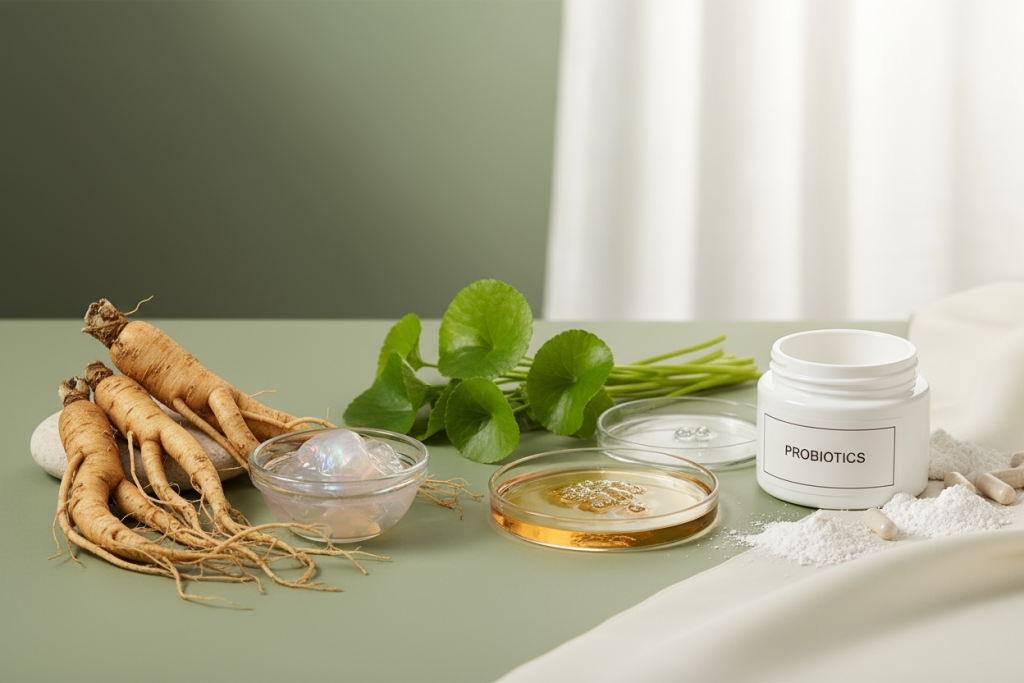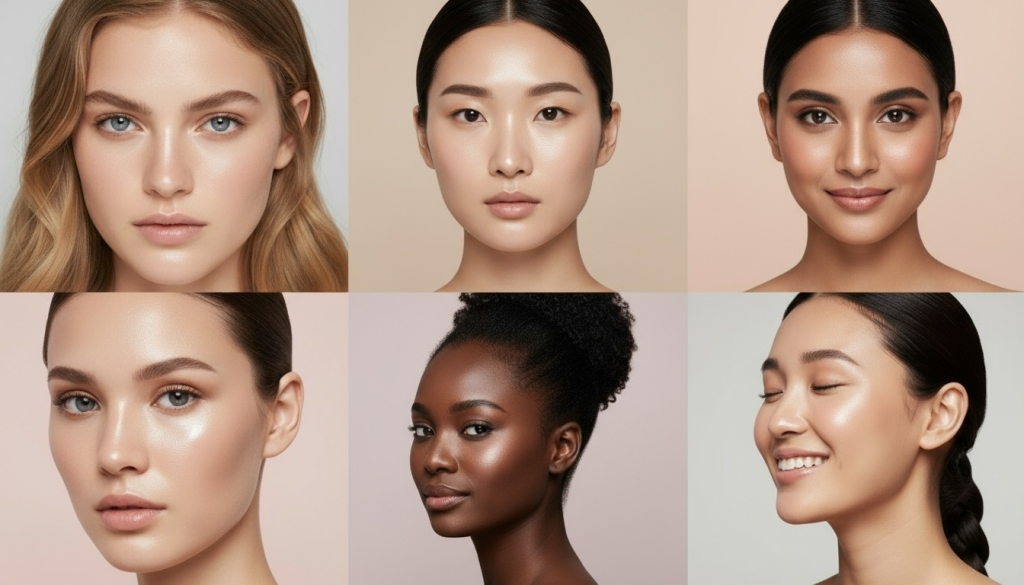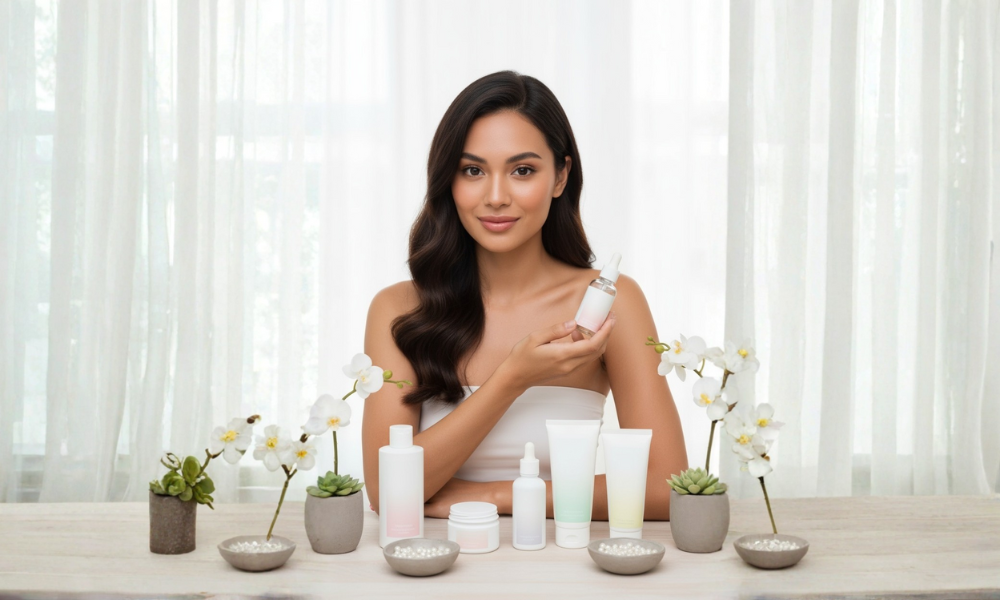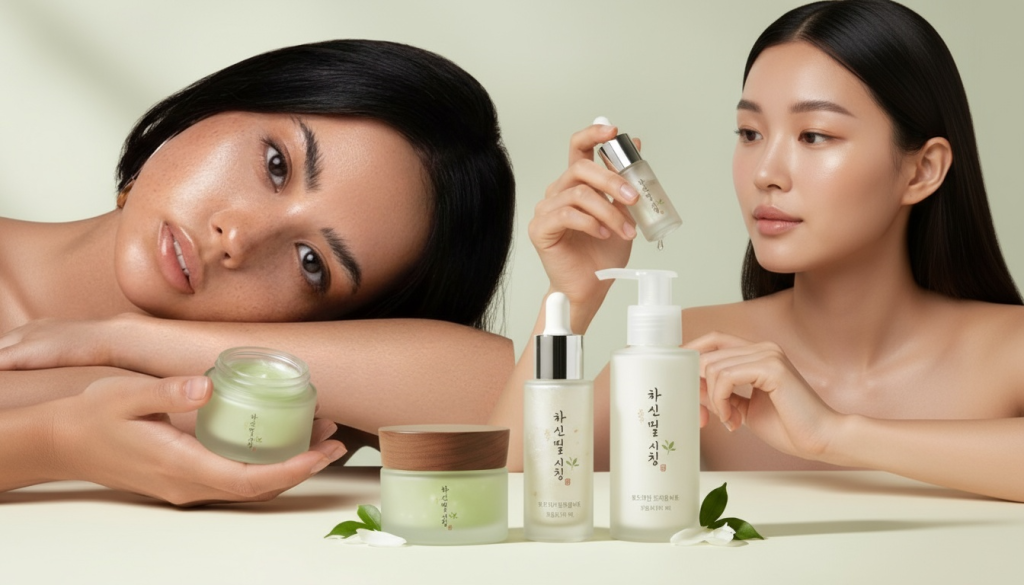In the last decade, Korean cosmetics—globally known as K-Beauty—has transcended its Asian origins to become an essential reference in beauty product development. What began as a trend among digital consumers has transformed into an innovation model that today influences brands worldwide, including Europe and Latin America.
K-Beauty has not only redefined the aesthetic standards of the industry; it has also introduced new ways of understanding skincare routines, the value of sensoriality, prevention as the cornerstone of treatment, and cosmetics as an emotional experience. All of this is driven by a highly sophisticated industry, with cutting-edge R&D and an enormous capacity for adaptation.
For emerging brands, Korean influence represents both a source of inspiration and a challenge. How can this model be translated to local contexts? Is it possible to replicate its level of innovation under European regulations?
In this article, we analyse the key elements of K-Beauty, its ingredients and philosophy, and how it can be integrated into product development from an OEM/ODM approach like that of MS Cosmetics Lab, with guarantees of quality, regulatory compliance, and sensorial efficacy.
1. Principles of K-Beauty: Ritual, Layering, Sensoriality, and Preventive Care
Beauty as Ritual: A Daily Discipline
Unlike the traditional Western approach, where cosmetics are often associated with correcting visible signs (spots, wrinkles, acne), K-Beauty promotes a comprehensive concept of preventive care. The skin is treated as a reflection of overall wellbeing, and its care forms part of the daily routine, not as an emergency but as an investment.
This principle is reflected in extensive yet flexible routines, with multiple steps whose objective is not quantity, but consistency and personalisation. The ritual is as important as the product, and this philosophy has redefined modern consumer expectations.
Layering: Layers That Work in Synergy
The layering method consists of applying products in a specific order, from lightest to heaviest density, allowing each one to fulfil a specific function and enhance the next. This encourages the development of:
- Ultra-light textures with rapid absorption
- Compatible formulations, without occlusive ingredients that interfere with each other
- Modular systems, adaptable to climate, skin condition, or time of day
This approach has stimulated the emergence of innovative formats such as essences, aqueous serums, concentrated ampoules, and sleeping masks, which combine potent actives with almost imperceptible textures.
Sensoriality as Part of Treatment
In K-Beauty, the sensorial experience is not an accessory; it is part of the efficacy. Texture, fragrance, and method of application contribute to treatment adherence and the user’s emotional wellbeing.
Emulsion-gels, creamy gels, microemulsions, and biphasic lotions are examples of formulas designed to provide a pleasant tactile experience that leaves no greasy residue but does leave a sensation of comfort and freshness.
Furthermore, priority is given to gentle, natural fragrances or those inspired by aromatherapy, which reinforce the emotional dimension of the daily ritual without overwhelming the senses.
Prevention Before Correction
One of K-Beauty’s most solid contributions to cosmetic innovation is its emphasis on prevention. Rather than treating deep wrinkles or established spots, the objective is to maintain healthy skin, with an intact skin barrier, constant hydration, and balanced microbiota.
This has driven the development of lines focused on:
- Deep and progressive hydration
- Strengthening barrier function
- pH regulation and sebum control
- Reduction of oxidative stress
It is an approach that directly dialogues with scientific cosmetics, as it does not exclude clinical evidence but integrates it into a holistic vision.
Cultural and Scientific Values Underpinning the Model
Behind K-Beauty’s aesthetics lies a deep cultural framework that combines:
- An ancient herbal tradition
- A culture that values discipline, purity, and harmony
- A cosmetics industry with strong investment in R&D—regulated, competitive, and highly technological
This combination of tradition and science explains why K-Beauty has managed to develop products that are not only visually appealing, but also technically advanced, with well-formulated active ingredients, clinical studies, and highly agile innovation cycles.
Signature K-Beauty Ingredients
One of K-Beauty’s greatest differentiators is its choice of ingredients. Far from following passing trends, Korean cosmetics combine traditional extracts with cutting-edge biotechnology, yielding highly effective, well-tolerated, and scientifically supported actives.

Ginseng: Revitalisation and Cellular Longevity
Ginseng, known as the “red gold of Asia”, is a central ingredient in traditional Korean medicine. In cosmetics, it is valued for its ability to:
- Stimulate microcirculation
- Boost cellular energy
- Combat free radicals
- Improve skin tone and elasticity
Its extracts are used in anti-ageing, revitalising products and energising serums, where its antioxidant profile contributes to brighter, more resilient skin.
Centella Asiatica (Cica): The Universal Repairer
Centella asiatica, also known as Cica, is another pillar of K-Beauty. Traditionally used to heal wounds, in cosmetics it is employed for its ability to:
- Soothe irritation
- Repair the skin barrier
- Promote collagen synthesis
It features in formulations for sensitive, acne-prone, or redness-prone skin, and has become popular worldwide for its efficacy and tolerance.
Snail Mucin: Intensive Regeneration and Hydration
Although its use initially sparked controversy, snail mucin has evolved into purified, standardised, and ethically sourced versions. It provides:
- Allantoin, glycolic acid, and regenerative enzymes
- Hydrating, healing, and softening properties
- Visible improvement in texture, dark spots, and firmness
Today it forms part of bestselling creams, essences, and gels, especially for dry skin or post-treatment care.
Ferments and Probiotics: Biological Technology Applied to Skin
Korean cosmetics pioneered the introduction of ferments and probiotic actives in formulations, anticipating the current microbiome trend. These ingredients:
- Improve the bioavailability of other actives
- Strengthen the skin microbiota
- Increase tolerance in sensitive skin
Common examples include lactobacillus ferment, bifida ferment lysate, or yeasts fermented with rice or green tea.
Other Key K-Beauty Ingredients
| Ingredient | Main Function | Cosmetic Application |
| Green tea | Antioxidant, anti-inflammatory | Toners, masks, cleansers |
| Niacinamide | Brightening, sebum-regulating, anti-dark spot | Serums, multi-function creams |
| Fermented rice | Hydrating, soothing, depigmenting | Essences, toners, sleeping masks |
| Peptides | Anti-ageing, firming, regenerative | Eye creams, serums, anti-ageing |
| Hyaluronic acid | Multi-layer hydration | All types of hydrating products |
The combination of these ingredients, together with innovative delivery systems and optimised pH, has produced highly functional, sensorial, and stable formulations.
How K-Beauty Transformed the Western Industry
Ultra-light, Multi-functional Textures: A New Way to Formulate
One of K-Beauty’s main influences on Western cosmetics has been the adoption of light, non-greasy, fast-absorbing textures that are highly compatible with other products. This layering-derived approach has prompted European and American laboratories to develop:
- Aqueous serums with high concentrations of actives
- Gel creams that deliver hydration without weight
- Hybrid essences with antioxidant and depigmenting functions
These innovations have generated a new generation of multi-functional formulations where efficacy goes hand in hand with sensorial pleasure.
Innovative, Emotive Packaging
Visual aesthetics are another key contribution. K-Beauty not only prioritises packaging functionality, but also embraces emotional design: soft colours, playful illustrations, tactile materials, and innovative formats such as:
- Single-dose ampoules
- Cushion compacts
- Dual-use lip and cheek tints
This approach has influenced more creative, visual, and experiential product design in Europe, without losing regulatory sobriety.
Storytelling Centred on Self-Care
Whilst traditional Western cosmetics prioritised technical claims, K-Beauty introduced a narrative focused on wellbeing, personal routine, and the pleasure of daily care. Brands adopted this discourse and adapted it to their cultures:
- Promotion of personal time
- Night-time rituals as part of rest
- A healthy-skin aesthetic rather than “perfect” skin
The result is more empathetic, emotional, and realistic language that improves consumer connection.
Examples of Adoption by Western Brands
The Korean impact is evident across many Western brands:
- La Roche-Posay and Avène have launched hydrating toners and essences with textures inspired by K-Beauty.
- Garnier, L’Oréal, and Nivea incorporated sleeping masks and lightweight serums into their portfolios.
- Indie brands such as Glow Recipe, Versed, and Krave Beauty fully embraced the Korean approach with natural ingredients, elevated sensoriality, and innovative formats.
This convergence has led European and Latin American consumers to no longer view multi-step routines as “exotic”, but as practical, effective solutions.
Technical Impact: Hydration, Microbiome and Skin Barrier Protection
At the level of scientific formulation, the influence of K-Beauty has prompted a reassessment of priorities. The focus on:
- Multi-layer hydration (hyaluronic acids of different molecular weights)
- Skin microbiome care through prebiotics and ferments
- Barrier repair with ceramides, squalane, panthenol and omega 3-6-9
has generated a symbiosis between the Korean sensorial approach and European pharmaceutical precision.
In the following section, we will analyse where K-Beauty is evolving and how it integrates with sustainability and biotechnology.
4. Predictions Towards 2026: Skinimalism, Glass Skin and Biotech-Beauty
K-Beauty continues to evolve and anticipate global trends. Beyond its recognisable aesthetics, what maintains its leadership is its ability to adapt to new consumer demands: sustainability, proven efficacy, fewer steps, more science and transparency.
Looking towards the coming years, four major axes of evolution are projected.

Skinimalism: Efficacy with Fewer Steps
In contrast to the 10-step or more routines that popularised K-Beauty in its early days, skinimalism now prevails: a philosophy that proposes reducing the number of products without sacrificing efficacy. This trend responds to a more informed consumer who prioritises quality, sustainability and simplicity.
This concept promotes:
- Multifunctional formulations, with actives that fulfil multiple roles (e.g. niacinamide + panthenol + hyaluronic acid)
- Hybrid products that combine toner + essence + serum in a single step
- Simplified routines that reduce packaging waste and minimise environmental impact
Furthermore, skinimalism drives greater cosmetic education by encouraging conscious and appropriate use of products. It involves teaching consumers to identify active ingredients, choose products according to their skin type and reduce unnecessary consumption.
Product development along these lines demands:
- A high concentration of functional actives
- Good dermatological compatibility
- Elegant textures that deliver visible results without overloading the skin
For European and Latin American brands, this trend opens opportunities to offer compact, sustainable and technically advanced solutions, particularly attractive to urban, eco-conscious and minimalist consumers.
Glass Skin: Skin as a Mirror of Health
Glass skin—translucent, hydrated skin without visible imperfections—remains an aesthetic ideal driven by K-Beauty. It is not about makeup or covering imperfections, but about achieving visibly healthy skin through preventive care.
To achieve this, formulations focus on:
- Deep and progressive hydration, with sustained-release systems
- Depigmenting and antioxidant actives, such as niacinamide, tranexamic acid or rice extract
- Second-skin effect textures that seal in hydration without a greasy sensation
Products aimed at the glass skin effect must also incorporate microemulsion or lamellar emulsion technologies, which promote active penetration and enhance sensorial perception.
In the West, glass skin has been reinterpreted as part of a trend towards “healthy skin without filters”, which values naturalness and seeks tangible results with less cosmetic coverage. This opens new space for sensorial dermocosmetic formulas with clinical backing.
Biotech-Beauty: When Science Enhances the Natural
Biotechnology applied to cosmetics—biotech-beauty—positions itself as a logical evolution of K-Beauty, where the natural and technological coexist harmoniously. Instead of relying exclusively on botanical extracts, bioidentical ingredients are generated with greater efficacy, purity and sustainability.
Key processes include:
- Controlled fermentation to improve bioavailability and stability
- Enzymatic engineering to generate functional molecules with lower impact
- Synthetic biology to reproduce hard-to-access actives or protect endangered species
Examples on the rise:
- Galactomyces or Bifida ferments as microbiome enhancers
- Biomimetic peptides designed to stimulate collagen without causing irritation
- Organic acids and exfoliating enzymes obtained through biotechnological processes
This approach enables the development of formulas with greater traceability, consistency and clinical profile, which is particularly relevant for demanding consumers and regulated markets such as the EU.
It also opens the door to personalised solutions adaptable to different climates, skin types or cultural requirements, strengthening the bridge between Asian innovation and European technical development.
Sustainable K-Beauty: From Aesthetics to Ethics
In a global context where ethics and sustainability are as relevant as efficacy, K-Beauty has begun to integrate responsible practices at every stage. Among the notable advances:
- Eco-conscious packaging: biodegradable, refillable or from recycled sources
- Ingredient upcycling, utilising by-products from the food industry
- Regenerative agriculture and sustainable crops for key ingredients such as ginseng or centella
Systematic environmental impact assessment is also promoted through methodologies such as LCA (Life Cycle Assessment) and the implementation of standards such as ISO 16128 to define the natural and organic percentage of formulations.
In South Korea, public policies have been implemented aimed at what is known as K-Green Beauty, encouraging:
- Research into sustainable ingredients
- The circular economy
- Reducing water use in industrial processes
For brands wishing to align with this vision, the challenge lies in designing products where sustainability is not an add-on, but a criterion from the formulation and design phase.
MS Cosmetics Lab’s Vision: Convergence of Science, Sensoriality, and Sustainability
At MS Cosmetics Lab, we observe that this evolution of K-Beauty is entirely consistent with the innovation objectives of many European and Latin American brands.
Our OEM/ODM approach is based on:
- Applying certified biotechnological processes with safe, clinically validated ingredients
- Developing sophisticated, sensorial textures tailored to different cultural habits
- Including ecodesign principles, from raw material procurement to packaging design
- Adapting Asian innovations to European and LATAM regulatory frameworks, ensuring safety and compliance
Thanks to our international experience and technical capabilities, we support brands seeking to differentiate themselves with K-Beauty-inspired propositions whilst maintaining their own identity, adapted to their local consumers and validated by science.
Keys to Adapting Korean Philosophy to a European or Latin American Brand
Adopting K-Beauty principles does not mean literally copying the Korean model. It means reinterpreting its fundamental values—prevention, sensoriality, technical innovation—to translate them into local cultural, regulatory, and commercial contexts.

Below are the keys to achieving this effectively:
Reinterpreting the Ritual: From Extended Time to Mindful Moment
The Korean ritual may be lengthy, but in the West it is often perceived as impractical. The key lies in preserving the intention (mindful self-care) without imposing multiple steps.
Recommended strategies:
- Offer “all-in-one” products that maintain efficacy without demanding excessive time
- Create educational campaigns about the benefits of brief but consistent routines
- Emphasise self-care as a personal moment, beyond the number of products
Adapting Layering to More Functional Formats
Although layering is part of K-Beauty’s DNA, not all markets are prepared to adopt multiple products. Some ways to integrate it seamlessly include:
- Modular textures: combinable boosters, serums, and toners
- Hybrid emulsions: cleansing + treatment, moisturiser + anti-ageing
- Curated sets or rituals for different needs (climate, skin type, age)
The objective is to preserve the technical benefit of the layered system without requiring a radical change in consumer habits.
Regionalised Sensoriality
Gel-like, watery, or sleeping mask textures are valued in Asia, but may need adjustments to be accepted in dry climates or cultures that prefer richer creams.
Possible adaptations:
- Reformulation of bases with local plant-based emollients
- Aromatic adjustments according to regional preferences (citrus, floral, herbal)
- Inclusion of ingredients with local heritage: Mexican aloe vera, Patagonian rosehip oil, Mediterranean calendula, etc.
OEM/ODM with International Experience: Bridging Cultures
Working with an OEM/ODM laboratory such as MS Cosmetics Lab enables the development of K-Beauty-inspired products that meet European regulatory and sensorial standards.
Our team offers:
- Adaptation of Asian ingredients with certified European equivalents
- Technical reformulation under EU criteria (pH, preservatives, allergens, permitted claims)
- Development of complete lines with adapted ritual logic: cleansing, hydration, protection
Additionally, we assist in designing coherent brand narratives without exaggerations or empty promises, focusing on real results and measurable sensoriality.
Examples of Successful Adaptation
- A niche brand in Spain that integrated a three-step routine with ferments and hybrid textures: it successfully positioned itself in pharmacies as a “smart routine”
- A Latin American start-up that combined glass skin concepts with local ingredients such as passion fruit and camu camu, creating an exportable line with regional identity
- A clean European brand that reformulated its moisturising line with fermented actives to improve bioavailability and differentiate itself in the “natural with science” segment
In all cases, the key was not to imitate literally, but to reinterpret Korean philosophy under their own identity, scientifically validated and tailored to the target consumer.
Conclusion
K-Beauty is not a passing trend: it is a consolidated innovation model that has redefined cosmetic product development globally. Its combination of preventive philosophy, sensorial experience, biotechnological ingredients, and emotional design has marked a watershed moment in the industry.
Beyond its cultural origins, its principles are adaptable and scalable. Brands that understand how to translate this vision to their own markets—without falling into superficial imitation—will be able to differentiate themselves with high value-added propositions.
The current convergence between K-Beauty, biotechnology, sustainability, and responsible formulation opens fertile ground for creating functional, sensorial, and competitive products.
At MS Cosmetics Lab, we help brands integrate Korean innovation into European or Latin American projects, with sensorial, safe, and sustainable formulations adapted to the regulatory and technical profile of each market.
Contact us to develop K-Beauty-inspired products with their own unique identity and the backing of a European OEM/ODM laboratory with global vision.




